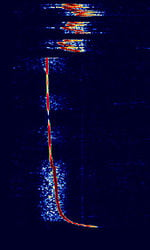Driftnet Buoy Radio Beacon
Driftnet Radio Buoys (DRB) are extensively used by fishing boats operating in open seas and oceans for collecting long fishing lines or fishing nets, with the assistance of a radio direction finder
DRB's use either Morse Code (CWContinuous Wave) or a variety of dots and tones for uniquely identifying them. DRB's have a distinctive trait of long pauses and long preamble tones before transmitting their unique identifier. In addition, there is significant frequency drift that can be seen in some beacons; Driftnet buoys use batteries, so when the battery voltage starts to drop, frequency drift occurs in the transmission.
Samples[edit]
| Standard Buoy Signal | Freq-Drifting Buoy | 11-Dot Buoy |
|---|---|---|
Video Examples[edit]
Frequencies[edit]
Fishnet beacons are can be found between 1.6 and 4 MHzMegaHertz (MHz) 10^6 Hz, and are most often found in and above the 160-meter amateur radio band. Driftnet buoys are also seen in the 10m band.
Additional Links[edit]
- W8JI NDB and Fish Buoy Beacons
- QSL list of 10m Driftnet Beacons
- Wikipedia Driftnet Buoy Radio Beacons
- IARUMS Region 1 10m Buoys Report



